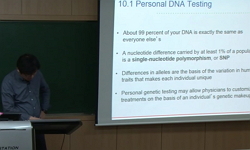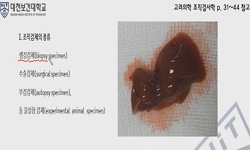Electrospinning is one of widely used methods fabrication of tissue engineering scaffold. Chitin, a natural polymer, is used as biomedical materials due to its biocompatibility and biodegradability. This study is to obtain the chitin nanofibrous scaff...
http://chineseinput.net/에서 pinyin(병음)방식으로 중국어를 변환할 수 있습니다.
변환된 중국어를 복사하여 사용하시면 됩니다.
- 中文 을 입력하시려면 zhongwen을 입력하시고 space를누르시면됩니다.
- 北京 을 입력하시려면 beijing을 입력하시고 space를 누르시면 됩니다.


Thickness and Pore Size Control of Chitin Nanofibers by Ultra-sonication and Its Biological Effect in vitro
한글로보기https://www.riss.kr/link?id=A103816664
-
저자
Sumin Jung (Medical Sciences) ; E sle Kim (Korea Institute of Radiological and Medical Science) ; Bon Kang Gu (Korea Institute of Radiological and Medical Science) ; Yong Jae Gin (Korea Institute of Radiological and Medical Science) ; 박상준 (Korea Institute of Radiological and Medi) ; 권일근 (Kyung hee University) ; 김천호 (한국원자력의학원)
- 발행기관
- 학술지명
- 권호사항
-
발행연도
2012
-
작성언어
English
- 주제어
-
등재정보
KCI등재,SCIE
-
자료형태
학술저널
-
수록면
11-18(8쪽)
-
KCI 피인용횟수
0
- 제공처
-
0
상세조회 -
0
다운로드
부가정보
다국어 초록 (Multilingual Abstract)
Electrospinning is one of widely used methods fabrication of tissue engineering scaffold. Chitin, a natural polymer, is used as biomedical materials due to its biocompatibility and biodegradability. This study is to obtain the chitin nanofibrous scaffold for tissue engineering application. In this study, pore size and thickness of chitin nanofibous sheet controlled by ultra-sonication. The surface properties of chitin nanofibrous sheet and ultra-sonicated scaffold performed scanning electron microscopy and water contact angle. The cellular adhesion and migration on the chitin nanofibrous scaffolds were evaluated by MTT and hematoxylin & eosin staining, respectively. As the chitin nanofibrous sheet had above about 2.4 μm surface pore size, normal human dermal fibroblasts began to infiltration into the inside of scaffolds. And the scaffolds have larger pore size, cells more deeply infiltrated on scaffolds. According these results, the porosity and pore size of nanofibers have an effect on cellular migration. Therefore ultra-sonication method was appropriated to control of the pore size of chitin nanofibrous sheet. And the three dimensional chitin scaffolds might be a potential material as tissue engineering.
참고문헌 (Reference)
1 장미경, "생체의료용 재료로써 키틴.키토산의 특성" 한국공업화학회 19 (19): 457-465, 2008
2 E. S. K. Tang, "Ultrasonication of chitosan and chitosan nanoparticles" 265 : 103-114, 2003
3 B. G. Kong, "The preparation of chitin gel using α, β, γ-chitin as a sustained release matrices forms" 6 : 88-91, 2002
4 J. Rnjak-Kovacina, "Tailoring the porosity and pore size of electrospun synthetic human elastin scaffolds for dermal tissue engineering" 32 : 6729-6736, 2011
5 R. Jayakumar, "Sulfated chitin and chitosan as novel biomaterials" 40 : 175-181, 2007
6 Y. Fan, "Preparation of chitin Nanofibers from Squid Pen β-chititn by Simple Mechanical Treatment under acid conditions" 9 : 1919-1923, 2008
7 정무상, "Preparation and characteristics of hybrid scaffolds composed of beta-chitin and collagen" ELSEVIER SCI LTD 25 : 2309-2317, 200405
8 정영일, "Physicochemical characterization of alpha-chitin, beta-chitin, and gamma-chitin separated from natural resources" JOHN WILEY & SONS INC 42 : 3423-3432, 200407
9 R. Jayakumar, "Novel chitin and chitosan nanofibers in biomedical applications" 28 : 142-150, 2010
10 J. Rnjak-Kovacina, "Increasing the pore size of Electrospun Scafflds" 17 : 365-372, 2011
1 장미경, "생체의료용 재료로써 키틴.키토산의 특성" 한국공업화학회 19 (19): 457-465, 2008
2 E. S. K. Tang, "Ultrasonication of chitosan and chitosan nanoparticles" 265 : 103-114, 2003
3 B. G. Kong, "The preparation of chitin gel using α, β, γ-chitin as a sustained release matrices forms" 6 : 88-91, 2002
4 J. Rnjak-Kovacina, "Tailoring the porosity and pore size of electrospun synthetic human elastin scaffolds for dermal tissue engineering" 32 : 6729-6736, 2011
5 R. Jayakumar, "Sulfated chitin and chitosan as novel biomaterials" 40 : 175-181, 2007
6 Y. Fan, "Preparation of chitin Nanofibers from Squid Pen β-chititn by Simple Mechanical Treatment under acid conditions" 9 : 1919-1923, 2008
7 정무상, "Preparation and characteristics of hybrid scaffolds composed of beta-chitin and collagen" ELSEVIER SCI LTD 25 : 2309-2317, 200405
8 정영일, "Physicochemical characterization of alpha-chitin, beta-chitin, and gamma-chitin separated from natural resources" JOHN WILEY & SONS INC 42 : 3423-3432, 200407
9 R. Jayakumar, "Novel chitin and chitosan nanofibers in biomedical applications" 28 : 142-150, 2010
10 J. Rnjak-Kovacina, "Increasing the pore size of Electrospun Scafflds" 17 : 365-372, 2011
11 J. Nam, "Improved Cellular Infiltration in Electrospun Fiber via Engineered Prosity" 13 : 2249-2257, 2007
12 양대혁, "Highly Porous Electrospun Nanofibers Enhanced by Ultrasonication for Improved Cellular Infiltration" MARY ANN LIEBERT INC 17 (17): 2695-2702, 201111
13 M. R. Kassi, "Fragmentation of chitosan by ultrasonic irradiation" 15 : 1001-1008, 2008
14 K. Sisson, "Fiber diameters control osteoblastic cell migration and differentiation" 94A : 1312-1320, 2010
15 H. M. Powell, "Fiber density of electrospun gelatin scaffolds regulates morphogenesis of dermal-epidermal skin substitutes" 84 : 1078-1086, 2007
16 S. P. Zhong, "Fabrication of large pores in electrospun nanofibrous scaffolds for cellular infiltration:A review" 9 : 1-29, 2011
17 B. Dhandayuthapani, "Fabrication and characterization of chitosan-gelatin blend nanofibers for skin tissue engineering" 264-272, 2010
18 진형준, "Electrospun silk-BMP-2 scaffolds for bone tissue engineering" ELSEVIER SCI LTD 27 : 3115-3124, 200606
19 Q. P. Pham, "Electrospun poly(epsiloncaprolactone) microfiber and multilayer nanofiber/microfiber scaffolds: characterization of scaffolds and measurement of cellular infiltration" 7 : 2796-2805, 2006
20 C. S. Ki, "Electrospun Three-Dimensional silk Fibroin Nanofibrous Scaffold" 106 : 3922-3928, 2007
21 M. P. Prabhakaran, "Electrospun Biocomposite Nanofibrous Scaffolds for Neural Tissue Engineering" 14 : 1787-1797, 2008
22 C. K. S. Pillai, "Electrospinning of Chitin and Chitosan Nanofibers" 22 : 179-201, 2009
23 E. Machova, "Effect of ultrasonic treatment on the molecular weight of carboxymethylated chitinglucan complex from Aspergillus niger" 5 : 169-172, 1999
24 H. Liu, "Effect of ultrasonic treatment on the biochemphysical properties of chitosan, Carbo" 64 : 553-559, 2006
25 C. R. Yoo, "Effect of chitin/silk fibroin nanofibrous biocomponent structures on interaction with human epidermal keratinocytes" 42 : 324-334, 2008
26 R. Jayakumar, "Development of novel chitin/nanosilver composite scaffolds for wound dressing applications" SPRINGER 21 (21): 807-813, 201002
27 C. S. ki, "Development of 3-D nanofibrous fibroin scaffold with high porosity by electrospinning : implications for bone regeneration" 30 : 405-410, 200
28 K. Kurita, "Controlled functionalization of the polysaccharide chitin" 26 : 1921-1971, 2001
29 나재식, "Chitosan의 초음파분해와 온도영향" 한국키틴키토산학회 14 (14): 155-159, 2009
30 R. Jayakumar, "Chitin scaffolds in Tissue Engineering" 12 : 1876-1887, 2011
31 K. E. Park, "Biomimetic nanofibrous scaffolds:Preparation and characterization of chitin/silk fibroin blend nanofibers" 38 : 165-173, 2006
32 R. Jayakumar, "Biomaterials based on chitin and chitosan in wound dressing applications" 29 : 322-337, 2011
33 T. Kawai, "Biological Fixation of Fibrous Materials to Bone using Chitin/Chitosan as a Bone Formation Accelerator" 88 : 264-270, 2009
34 S. Sowmya, "Biocompatibleβ-chitin Hydrogel/Nanobioactive Glass Ceramic NanocompositeScafolds for Periodontal Bone Regeneration" 25 : 1-11, 2011
35 X. Xu, "Antimicrobial gelatin nanofibers containing silver nanoparticles" 9 : 685-690, 2008
동일학술지(권/호) 다른 논문
-
압박 고나사의 생역학적 특성과 골반 골절 정복을 위한 임상적 의의
- 한국생체재료학회
- 하병조
- 2012
- KCI등재,SCIE
-
유기실란처리 실리카를 이용한 에폭시 나노복합소재의 제조 및 분석
- 한국생체재료학회
- 유태웅
- 2012
- KCI등재,SCIE
-
- 한국생체재료학회
- 김동빈
- 2012
- KCI등재,SCIE
-
히알루론산 함유 폴리비닐알콜 하이드로겔 패치의 제조 및 창상 치유 효능 평가
- 한국생체재료학회
- 남보라
- 2012
- KCI등재,SCIE
분석정보
인용정보 인용지수 설명보기
학술지 이력
| 연월일 | 이력구분 | 이력상세 | 등재구분 |
|---|---|---|---|
| 2023 | 평가예정 | 해외DB학술지평가 신청대상 (해외등재 학술지 평가) | |
| 2020-01-01 | 평가 | 등재학술지 유지 (해외등재 학술지 평가) |  |
| 2017-01-01 | 평가 | 등재학술지 유지 (계속평가) |  |
| 2013-01-01 | 평가 | 등재 1차 FAIL (등재유지) |  |
| 2010-01-01 | 평가 | 등재학술지 유지 (등재유지) |  |
| 2007-01-01 | 평가 | 등재학술지 선정 (등재후보2차) |  |
| 2006-01-01 | 평가 | 등재후보 1차 PASS (등재후보1차) |  |
| 2005-03-28 | 학회명변경 | 한글명 : 생체재료학회 -> 한국생체재료학회영문명 : 미등록 -> The Korean Society For Biomaterials |  |
| 2005-03-28 | 학술지등록 | 한글명 : 생체재료학회지외국어명 : Biomaterials Research |  |
| 2004-07-01 | 평가 | 등재후보학술지 선정 (신규평가) |  |
학술지 인용정보
| 기준연도 | WOS-KCI 통합IF(2년) | KCIF(2년) | KCIF(3년) |
|---|---|---|---|
| 2016 | 0.32 | 0.32 | 0.3 |
| KCIF(4년) | KCIF(5년) | 중심성지수(3년) | 즉시성지수 |
| 0.26 | 0.23 | 0.511 | 0.11 |




 KCI
KCI



